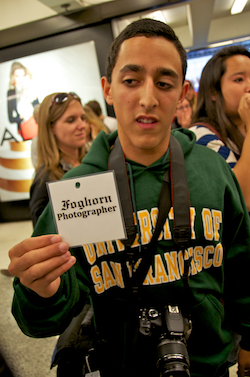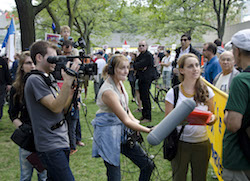SEJournal Online is the digital news magazine of the Society of Environmental Journalists. Learn more about SEJournal Online, including submission, subscription and advertising information.
EJ Academy: A (Student) Journalist’s Guide to Covering Dissent
By Beatrice Motamedi
 |
| Student journalists covering climate marches on April 29 need to know how to identify themselves in public. This student photojournalist from the University of San Francisco was arrested at a 2011 protest for a credential deemed inadequate by police. Photo: Steve Rhodes, Flickr Creative Commons |
They came — grandmothers and grad students, pediatricians, chemists and geologists but also history professors, high school teachers and at least one person carrying a sign with the molecular formula for hair spray.
Though a comprehensive count was not available as of April 24, USA Today estimated that “hundreds of thousands” of people participated in the first March for Science actions April 22 in Washington, D.C., as well as 500 sister marches around the world, including New York, Chicago and Los Angeles, plus Berlin, Brisbane, London and Paris.
It was a day of support not only for science but scientific reasoning, for geek over glamour, for marchers to get their nerd on. Participants wore their tools of the trade, including goggles, stethoscopes and gloves. In a nod to the Women’s March on Washington the day after President Trump’s inaugural, a group of scientists on Reddit debated if “lab coats will be the pussy hat of the March for Science?”
If you didn’t get a chance to cover the march, don’t despair — next Saturday will bring another opportunity.
The People’s Climate March on April 29 has thrown its hat in — so to speak — with the March for Science and will stage another gathering next Saturday in Washington, also with sister marches worldwide. Organizers say demonstrators in Washington will gather at the Capitol Building and march up Pennsylvania Avenue to the White House, where they will “make a loud sound (to) drown out all of the climate-denying nonsense that has been coming out of this (Trump) administration.”
Like the March for Science, the People’s Climate March is an opportunity for student (and citizen) journalists to cover science issues. But unlike veteran career reporters, new journalists may or may not know how to identify themselves in public, what to say if confronted by law enforcement, how to handle volatile crowd situations or whom to turn to for help.
So below is a primer for those student journalists who want to cover next week’s march — and those who teach them. It’s based on interviews with and information from the American Civil Liberties Union, the Committee to Protect Journalists, the Dart Center for Journalism and Trauma, the Electronic Frontier Foundation, and high school and college journalism advisers, as well as the Student Press Law Center, created by the Robert F. Kennedy Memorial in 1977 to protect the rights of young journalists.
Whatever else you take away from the rules below, remember: Journalism is the only profession explicitly protected by the Constitution. The First Amendment includes the right of assembly; in the same sentence, our founding fathers safeguarded freedom of speech and of the press. They go together.
So be careful out there. And here’s how to do your job.
12 tips for students covering the protest
Rule No. 1: Know who you are. You can be an activist or a journalist, but not both. It’s only logical: As an activist, you may actually want to get caught in a police sweep, resist arrest and/or spend the night in jail. But as a journalist, that could mean getting your equipment confiscated and missing deadline. Not good. Plus, certain legal protections (see #7 below) cover you only if you’re a journalist. As uncomfortable as it may feel, for practical, professional and ethical reasons, you can’t take sides.
NPR’s ethics handbook is a good example of the choice career journalists make: “NPR journalists may not participate in marches and rallies involving causes or issues that NPR covers, nor should they sign petitions or otherwise lend their name to such causes, or contribute money to them.”
Rule No. 2: Plan your reporting. While the number of people who turned out for the March for Science was large, and that for the Women’s March on Washington stunning — as many as 470,000, according to crowd scientists interviewed by The New York Times — arguably so was the planning. For the Women’s March, organizers created not just the usual Facebook page, but also a comprehensive website with resources including maps, an ACLU explainer on First Amendment rights for photographers and a video with advice on transit directions, possible weather conditions, exit routes and bathrooms.
The federal Privacy Protection Act prevents police
from seizing cameras, notepads, recorders and other
“work product materials” a journalist would use.
If the protest you’re attending has this level of information, great. But if not, create your own reporting plan. Besides who’s on the team and where you’ll be, discuss what type of content you’re after (interviews with particular people or types of people; photo, video, audio, other?), how much access you’ll need (general public? press credentials?), how you will identify yourself to others (press badge? other ID?), how you will get to the protest and where you will meet up, how often you will meet up, exit routes out of the area and what to do in case of emergency.
Exchange phone numbers for loved ones, legal hotlines and other emergency support. Put them into your phone(s) but print them out also in case cell networks go down. During Occupy New York in 2011, protesters used Sharpies to write key phone numbers on their arms. Do what you need to do in order to access information with or without a cellphone.
Rule No. 3: Gear up. Create your own mobile media kit with equipment you know you’ll need, such as camera (if not using your phone), lenses, external microphone, tripod, plus press badge, extra cellphone battery, emergency cash, reporter’s notebook/pens, a city map and a metro or bus card.
Optional but recommended are energy bars, boxed juice, prescription medication you would need if detained more than a few hours, a first-aid kit, a copy of your health insurance card including blood type and a light stick. Backpacks may be subject to search, so consider a smaller bag or tote, a jacket with pockets, or a clear plastic backpack that shows contents.
A press badge or pass will help you identify yourself to others, which is important for your sources and for you in case you need to tell law enforcement what you are doing. If you are part of a high school or college program, you probably already have a press badge. If not, the National Writers Union offers a “press pass” to members in good standing with published work.
If you want to create your own badge, John Bowen, chair of scholastic press rights for the Journalism Education Association, suggests that it “show PRESS/MEDIA in large letters and have it look and feel official,” including your photo. Put the pass into a plastic holder and attach it to a lanyard so you can wear it around your neck.
Press credentials or accreditations are different; in addition to identifying you, they grant special access to areas reserved for media. Credentials typically are given out by sponsoring organizations or law enforcement, and the application process for events such as a presidential inaugural can be time-consuming, requiring personal information and background checks.
While you don’t need credentials to report on a public event, it’s worth asking if they are available, assuming you have time to apply for one and that they will give you special access you wouldn’t otherwise get as a member of the public.
Rule No. 4: Map it out. “Know the area you are going to. Work out in advance what you would do in an emergency,” CPJ counsels. Of course, digital tools make that easy — Google Maps to navigate, local metro apps to track transit options, Foursquare Swarm, Waze and Find My Friends to locate buddies. But what will you do if cell networks go down?
The answer is old school: Print out an area map and highlight evacuation routes you can use either by car or by foot. If you are working with others, set up an emergency rendezvous point and discuss when you’ll be there (on the hour, every two hours, etc.) and how to respond if someone does not show up.
Identify the nearest local hospital and police station. Look for elevated places where you can get perspective and be safer than if you’re in the crowd. If possible, visit the protest site beforehand and get the lay of the land.
Rule No. 5: Prep your cell. When crowds are especially large, cellphones may not work due to overloaded networks or law enforcement restrictions. But there are off-the-grid options, for example, Firechat. A free messaging app that bypasses the internet and connects user to user via a mesh network that uses a phone’s wifi or Bluetooth, Firechat has become popular among protest groups in Taiwan, Iraq, Iran and most recently in South Korea. It’s also come into play during natural disasters such as floods in Kashmir (April 2015) and at Burning Man.
Also, protect your cell. Back up your data, set a strong PIN and turn off TouchID (police officers and border officials can force you to unlock it that way but not with a password).
The best protection against loss is encryption: In its “Digital Security Tips for Protesters,” the Electronic Frontier Foundation warns that “(p)rotest situations are often unpredictable, so losing your phone is (a) distinct possibility.” Learn how to encrypt your iPhone here and your Android phone here.
If you haven’t encrypted and you think your phone is about to be confiscated or stolen, shut it down. “Turning off your phone, with both iPhones and Androids, makes it much harder for police to access any data on it,” notes Michael Morisy, co-founder of MuckRock, an investigative news site that uses public records and Freedom of Information Act requests. “(T)his is particularly important for Android phones, so if you think it’s about to be confiscated, that’s a good move.”
 |
| Working in teams can be helpful, so that if one person gets into a confrontation, others can record and report it to help expedite a release if there's an arrest. Above, student journalists from Ryerson University in Toronto, during a protest at City Hall in 2011. Photo: Eric Parker, Flickr Creative Commons |
Rule No. 6: Work with others. “The single most important safety thing — and really this goes for anytime that you are a reporter — is to make sure someone knows where you’re going and check in regularly with your home base,” says Frank LoMonte, executive director of the Student Press Law Center.
Teams are helpful, “because often one person will get into a confrontation with police, and if they have a witness there to videotape and report to the publication that they need help, all the better. That will expedite getting a person released.”
Group messaging apps such as GroupMe, WhatsApp or Facebook Messenger can keep you connected to your team. Make sure your group is already working and debugged before you go.
Rule No. 7: Stand your ground but be polite. You heard right: Even though you have First Amendment rights as a citizen and a journalist, shouting them at a police officer who is struggling to control a raucous crowd may not work. But asking questions could.
“Try to pretend you’re on ‘Jeopardy,’” suggests the SPLC’s LoMonte. “If you say, ‘Officer, is there a place where it’s okay for journalists to be standing?’, that’s better than, ‘I know my rights and I know I can stand here.’ If you say, ‘Can I take a few steps back? Can I stand on this street corner instead?’ then you’re de-escalating and making it more of a conversation and less of an argument.”
Keep in mind that “you as a journalist don’t have any different rights from Joe Spectator, so any place that is legal for Joe to stand, it is legal for you to stand,” LoMonte adds. “But if people are telling Joe to leave, you need to leave, too.”
The exception is if a police officer tries to seize your equipment or to stop you from photographing or recording what he or she is doing. The federal Privacy Protection Act passed in 1980 prevents police from seizing cameras, notepads, recorders and other “work product materials” a journalist would use. The Supreme Court also has ruled repeatedly that citizens have a First Amendment right to take video and images of police activity.
If either of those things happen, assert yourself. “Give the time out signal, and say, ‘I think there are laws that protect me, and I’m going to call the hotline, and maybe you should check with a supervisor,’” LoMonte says.
Call the SPLC hotline at (202) 785–5450, file a legal request or tweet a call for help to @SPLC. Be sure to include your name and the name of your publication or Twitter handle so you can be located if your cellphone is seized.
Rule No. 8: File fast. Download Google Drive on your phone or tablet and upload photos and video to your editor as soon as you capture them. Snapchat, Instagram or post content to Facebook or Twitter. Or check out mobile storytelling apps that can help you build stories fast, such as Steller and Slide.ly.
Reporting quickly from the field is good journalistic practice but it also makes sense in case you lose your phone or your memory card is confiscated. Publishing as you go also creates geotags and timestamps that show others where you’ve been in case you don’t show up at a scheduled rendezvous. If you are worried about being traced or tracked, publish, then turn off your wifi till you get to your next location.
Rule No. 9: Don’t hide but don’t be obvious. “There are times when looking like a journalist is important to signal to others, including police, that you are there to observe,” says CPJ. But in some instances, clothing or caps with logos can inflame an already volatile situation. Use your judgment; keep your press badge handy but out of sight until you need to show it.
Be aware of risk and consider alternative ways to get the story as you go about your work, especially if you are shooting photo and video. “While there are times when documenting aggression is crucial journalistic work, be aware of the situation and your own safety,” CPJ advises. “Taking pictures of aggressive individuals can escalate a situation.” But you can always write or podcast about what you have seen or heard.
Rule No. 10: Put safety first and mind the crowd. Stanford University student Jack Hennessy was visiting Istanbul’s Dolmabahçe Palace in August 2015 when gunshots rang out. A correspondent for Global Student Square, Hennessy knew it could be a great story. But with the shooter unidentified and at loose, Hennessy did the right thing — he jumped over a fence to safety and called his editor in California. Once the gunman had been apprehended, Hennessy went back and reported his piece.
“I would advise anyone doing reporting in areas of dissent to go in groups — especially student journalists,” Hennessy says. “Also, in general, I would advise student journalists to stay mindful at all times about what the dynamics of the crowd look like. Is there any suspicious activity? Is the tenor of protest becoming more violent/less peaceful? These are things to stay aware of.”
When covering volatile street protests, “(r)eport on both sides of the conflict, but don’t get caught in the middle; know your exit route at all times; remain engaged but detached,” advises the Dart Center for Journalism & Trauma.
Rule No. 11: Seek some apps. Signal is free and offers end-to-end encryption. Zello turns your phone or tablet into a walkie-talkie so you can send messages directly to large groups. Find the nearest restroom with SitOrSquat. MySOSFamily (on Android and iOS beta) speeds your help request to colleagues or emergency contacts.
Keep an eye out for apps that pop up for specific protests; often they don’t last but in the moment they can be incredibly useful.
For instance, last fall, after noticing that protesters in Seoul had trouble finding restrooms and subway stops, a local university student came up with Candlelit Path, a mobile app that riffs on the “candlelight” protests calling for President Park Geun-hye to step down. Sukey was created by UK Uncut protesters in 2011 to prevent being “kettled” or detained by police behind barricades. Launched in response to Occupy New York, “I’m Getting Arrested” was briefly popular until it was overwhelmed with downloads and requests for new features.
Be sure to keep an eye on Facebook groups and Twitter feeds connected to your protest for updates and security alerts.
Rule No. 12: Research your rights and know who to call. “Unless (police) have a warrant or arrest you, they can’t take your device. Unless they have a warrant, they can’t search your device,” says MuckRock’s Morisy. The ACLU’s “Know Your Rights” explainer spells out the difference between public places (where you can take photo and video) and private space (where you cannot).
If you are attacked, threatened or otherwise intimidated while covering a protest, contact the Student Press Law Center (see above); reach out to CPJ by emailing report_violation@cpj.org; call or email the Reporters Committee for Freedom of the Press’ hotline at 800-336-4243 or hotline@rcfp.org (the organization also offers a digital journalist’s legal guide); or try the National Lawyers Guild website for a legal support hotline in an area near you.
And if you’re a high school student and/or under 18, your first call should be to family to explain where you are and ask for help, says LoMonte of the SPLC. Especially if you believe that you are about to be taken to a police station, “it’s not a bad idea to take off the journalistic hat and be a minor,” LoMonte says. “At that point your biggest job is to keep out of jail.”
Beatrice Motamedi is executive director of Global Student Square, an international student journalism network. She has covered and helped students cover protests, marches and other public events in Chicago, San Francisco, Oakland, Paris, Seoul and Washington, D.C. This is a modified, updated version of “A Citizen Journalist’s Guide to Covering Dissent” and is republished with permission.
* From the weekly news magazine SEJournal Online, Vol. 2, No. 17. Content from each new issue of SEJournal Online is available to the public via the SEJournal Online main page. Subscribe to the e-newsletter here. And see past issues of the SEJournal archived here.














 Advertisement
Advertisement 




